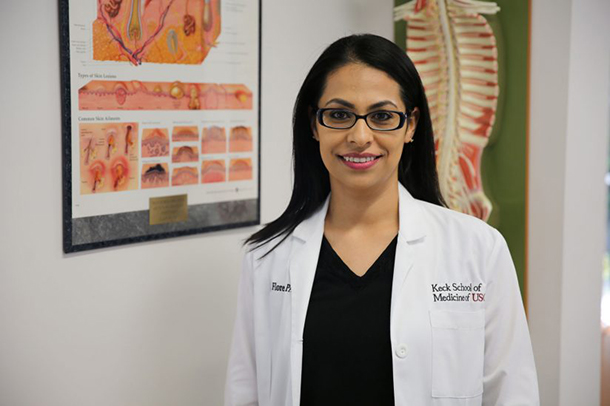As a Spanish-speaking native of L.A.’s South Gate neighborhood, Jessica Flores frequently accompanied her father to doctor visits to serve as translator, after realizing the language barrier with his doctor was interfering with his treatment.
Starting in July, Flores will serve local residents at a clinic in nearby Wilmington as a Spanish-speaking physician assistant with a master’s degree from the Primary Care Physician Assistant Program at the Keck School of Medicine of USC. As a PA, she’ll work alongside doctors at the clinic with their supervision. Patients won’t need to bring a translator, and Flores will be able to directly provide much of the care they need.
“We come from the same philosophy as a physician,” Flores said of her new profession. “We are able to take the patient’s history, do a physical exam, diagnose them, come up with a treatment plan, order labs, furnish drug orders. We work alongside the physician.”
The PA role is little-known and frequently misunderstood by people outside clinical medicine. A PA isn’t a “physician’s assistant,” she’s a clinician who works as an extender of care with a doctor. The PA profession was created in the late 1960s to let returning Vietnam veterans who had provided medical care overseas help meet a shortage of primary care providers.
The USC Primary Care PA Program is a 33-month, full-time program — a year longer than similar programs and with even more clinical rotation time working in hospitals or clinics.
Physician assistants are needed more than ever
PAs are in such high demand, especially in underserved communities short of doctors, that federal scholarships are available to students willing to work at urban and rural sites determined to be underserved by the National Health Service Corps, part of the U.S. Department of Health and Human Services. USC’s program requires a bachelor’s degree and certain class prerequisites, including a level of Spanish fluency. Medical Spanish is part of the curriculum.
For Flores, the mother of a 9-year-old son, the PA path had the appeal of offering more flexibility in work-life balance after graduation.
“We’re not limited to one specialty,” she said. “We can work in primary care, family medicine, internal medicine, pediatrics, women’s health or a specialty like general surgery or orthopedics — anywhere that we have a physician willing to have us on board and train us.”
The program opens a new door for students
PAs can take on a clinical residency after graduation, but unlike their MD counterparts, it’s not a requirement. For Flores, whose training included 30-hour shifts at Los Angeles County+USC Medical Center, this means being able to eschew the long duty cycles of a residency and find a role which will allow her to plan more time for her son.
Two-fifths of last year’s graduating class now work in underserved communities, said Claire Norman, public communications director for the program.
“I do hear a lot about the flexibility of the profession or the less time in school compared to medical school,” Norman said. “But overall, students share the story about the first PA they met and how it opened a whole new door for them.”
PA training may not be as long and intensive as med school, but Darryl Mayo, clinical coordinator and instructor for the program, said it still requires an innate passion and commitment to the long haul.
“All of our students at the USC PA Program are quite impressive,” he said. “But Jessica is a highlight because of her perseverance while being a committed single parent. The underserved community in which she intends to practice will be extremely fortunate to have her caring for their health needs.”
— Paul Boutin


